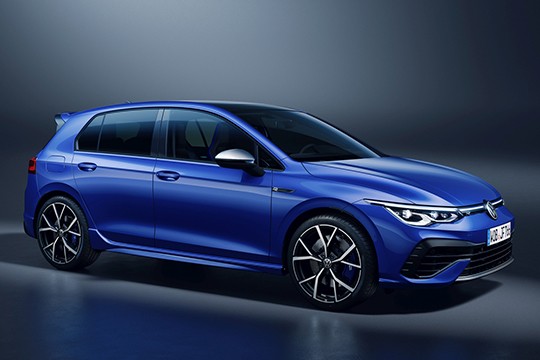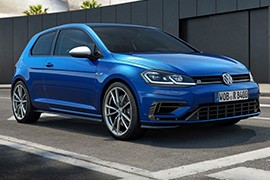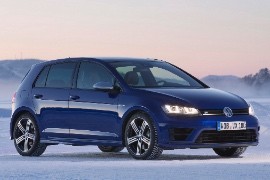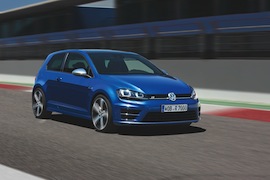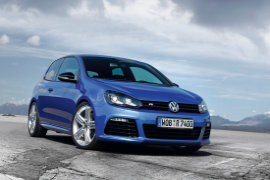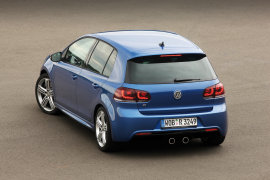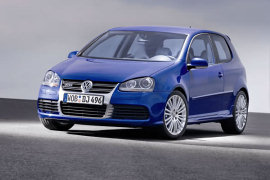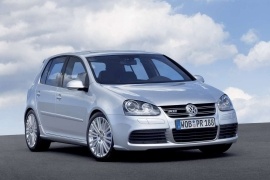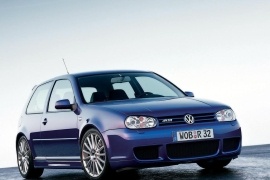VOLKSWAGEN Golf R Models/Series Timeline, Specifications & Photos
First production year: 2002
Engines: Gasoline
Body style: Hatchback
The Golf R reached its fifth generation and all offered sports car performances, with all-wheel-drive traction and aggressive look.
Volkswagen was considered the inventor of the hot-hatch category when it introduced the first generation of the Golf GTI. It was a segment that grew and, soon, other carmakers produced various performance vehicles in the segment. The Golf evolved and offered more and more performances, but they were no longer the kings of the hot-hatches despite their efforts. Honda, Ford, Renault, and Opel/Vauxhall, made a fierce competition. But the Golf R returned to fix that.
A hot-hatch doesn't have to look just as regular as the rest of the range. While on older models, there were just a few aesthetic differences, the Golf R went all the way. The taller bumper with huge grilles on the lower side and big side-pods made a perfect match for a car that had to look fierce. The new, slim headlights with an upper LED daytime running light strip made the vehicle looks mean. On the sides, there was a new aerodynamic package with side sills and a bigger rear roof-spoiler. In the back, the four exhausts were shown under the bumper, next to the splitter.
Such an aggressive look couldn't be complete without a race-inspired interior. The sport-bucket seats with integrated headrests for the front passengers were high-bolstered to keep their occupants in place while hard-cornering. The full-digital instrument cluster and the paddle-shifters behind the steering wheel made the car looks business.
For the drivetrain, Volkswagen installed a turbocharged inline-four gasoline engine. It was paired to either a 6-speed manual or a 7-speed DSG (dual-clutch) automatic transmission. Power went to all corners via a newly developed all-wheel-drive system with torque vectoring.
The Volkswagen Golf GTI was the inventor of the hot hatch segment, even though the original GTI only had 115 hp. Fast-forward to 2017 and we find the Golf R, a true contender in the hot hatch category. While the first ever Golf R had a naturally aspirated 3.2-liter V6 engine, the 2017 R has a 2.0-liter turbocharged gasoline unit with almost 300 hp under the hood. It is mated either with a 6-speed manual or a 7-speed DSG (dual-clutch).
From the outside, only the front bumper and the twin-dual exhaust will tell the difference compared to a regular model with options on it. The 19” wheels are standard for the R. Other Golfs with R-Design package don't have the same light-alloy-wheels. Differences continue on the inside, where nicely bolstered bucket seats are holding the front occupants while cornering.
The leather and fabric combination seats are nice to view as well, and the R-logo embodied on the seatback is visible. The dashboard has a TFT screen borrowed from Audi's Virtual Cockpit and it is customizable. The speedometer and tachometer are accompanied by other various information, including the sat-nav system squeezed in the middle on the screen.
On the center console, there is another big screen, this time with gesture controls so the owner won't have to clean fingerprints every day. It has Android Auto and Apple CarPlay compatibility.
But what makes the Golf R more special is the mechanical layout. The 300 hp and the all-wheel-drive system makes it a competitor for rally-inspired cars, such as the Subaru STI or the Ford Focus RS.
Volkswagen produced another serious contender for the hot hatch segment in 2013, the Golf R, which was also suitable for a young family thanks to its five-door bodywork.
While its GTI lineup was already known and appreciated on the market, Volkswagen learned from its customers that it was not enough. That famous car was oftentimes surpassed by the newcomers, such as the Impreza STI from Subaru or the Type R from Honda. As a result, it came with the R-Versions, which carried over its most significant parts from its posher sibling, the S3 from Audi.
Even though it shared many components with its lesser-powered siblings from the Golf seventh generation, the R-version came with a unique front fascia that featured a chromed slat on the grille and a lower bumper that sported a trapezoidal grille. In addition, that was flanked by a pair of functional scoops. From its profile, the Golf VII R featured a specific badge on the front fenders and version-specific "Cadiz" 18" light-alloy wheels, with an option for a 19" set. At the back, the automaker installed a new bumper with a diffuser flanked by chromed exhausts.
Inside, Volkswagen installed a set of standard sports seats at the front with fabric upholstery. As an option, customers could choose Nappa leather-wrapped interior. In addition, all versions featured the R-letter embroidered on the front seats' seatbacks. At the back, the automaker used the same materials for the split-folding bench seat. To further enhance the sporty spirit, the Golf VII R featured stainless steel pedals and the dead pedal.
With a drivetrain carried over from its posher sibling, the S3 from Audi, the Golf VII R boasted a turbocharged, direct fuel-injected inline-four that produced 300 PS (296 hp) sent in all corners via a fifth-generation Haldex all-wheel-drive system, with electronically controlled differentials on both axles. Customers could get the car with either a six-speed manual or a six-speed automatic (dual-clutch). The latter was also quicker in the 0-62 mph (0-100 kph) sprint than the former one.
$34,000 for a Golf? Well, yes. And the reason why would be the way the Gold R provided a strong performance, with a very sharp handling.
The Gold VII R provided all-weather traction, along with great comfort for longer journeys.
The interior was built was premium quality materials and it was nicely finished. While comfortable and agile, it also offered great versatility.
The cabin was roomy, offering the passengers great space.
The Golf R was available in a 2-door or a 4-door body shape and a single trim was offered.
The standard features included 18-inch alloys, a sport suspension, adaptive bi-xenon headlights, heated mirrors, LED running lights, cruise control and many other features, enough to conclude that the R was greatly equipped even without any optionals included.
Two packages were available for the trim, the Sunroof and the Navigation package that added keyless ignition and a premium audio system.
The Gold R came with a turbocharged 2.0-liter 5-cylinder engine that produced 256 hp and 243 pound-feet of torque. The sports car came with a standard all-wheel-drive system and a manual transmission.
Safety wise, the Golf R was equipped with antilock disc brakes, stability and traction control.
The interior was impeccably finished, with some accents borrowed from Audi. The Golf R came with a standard touchscreen Audi interface and an optional navigation system.
Volkswagen introduced a sportier version of the Golf VI one year after launching the sixth generation of the famous compact hatchback, and, of course, it offered it in a three-door version.
When the carmaker launched the first generation of the Golf GTI, it made it with three doors, and that became the usual bodywork version for all the other performance-oriented Golfs. The five-doors or the station wagons shapes were the added ones. But the original was with just three, like this Golf VI R.
Walter da Silva was in charge of designing the Golf VI, and for the R version, he added a beefier bumper with a wide grille in the middle and two side scoops to cool the brakes. Moreover, the LED headlights were fitted as standard, and they were a far better match for this aggressive-looking hot-hatch. But the designer also enhanced the side view of the car with unique side skirts, while at the back, he added a splitter under the bumper and two center-mounted exhausts. Last but not least, a roof spoiler adorned the top of the tailgate.
Inside, the high-bolstered bucket seats were designed to offer better side support during high-speed cornering when compared with other Golf versions. Like in any other three-door Golf, access in the rear was possible by tilting the front seats forward. But they still offered a decent amount of room for two adult passengers.
Under the hood, the Volkswagen installed a highly tuned 2.0-liter turbocharged gasoline engine. It produced a massive 270 hp, 20 more than on the R32, its rightful predecessor. It sent the power in all corners via a new all-wheel-drive system via a six-speed manual or a six-speed automatic (DSG).
Volkswagen came on the market with the R-version for its Golf range one year after it unveiled the sixth generation of its compact hatchback.
The Golf was already a phenomenon, and Volkswagen tried its best to stay ahead of everyone else in the hot-hatch territory. Previously, it had the R32 version, where the number displayed the engine displacement. For the 2009 model, it dropped that and kept only the R.
Walter da Silva designed the sixth Golf generation, and he took care of the R-version look as well. Thus, he installed a taller bumper with a broad grille in the middle and two side-scoops needed to cool the brakes, where he placed the daytime running lights. The new LED headlights came fitted as standard on the R-version. The sills were slightly reshaped from its sides, while in the back, the car featured a splitter under the bumper and a center-mounted dual exhaust. To complete its sporty-look, the designer added a unique roof-spoiler at the top of the tailgate.
Inside, the car went through an upgrade compared with its siblings and received bucket-seats with high bolstering. It was an all-wheel-drive sports car, and the occupants had to be kept in place during hard cornering, at least the front ones. In the back, it was the same bench as the rest of the range. Volkswagen installed a specific steering wheel with a silver badge that sported a blue R letter on the lower spoke for.
Under the hood, the German carmaker installed a highly tuned 2.0-liter turbocharged gasoline engine. It produced 270 hp, 20 more than on its R32 predecessor. It sent the power in all corners via a new all-wheel-drive system via a six-speed manual or a six-speed automatic (DSG).
Volkswagen introduced the second generation of its mighty R32 Golf in 2005, thus creating a super hot hatch on a market where customers were eager for more power.
The German carmaker is often credited as the inventor of the hot-hatch segment with the first Golf GTI. But with more and more competitors in that niche market, it had to come up with new ideas. Thus, it came with bigger engines, and the 3.2-liter V-6 seemed to be the answer to all its problems. Like a true hot-hatch, the car was available with a three-door bodywork.
Even though the carmaker tried to hide the R32's true nature, the result was not a subtle car. The car showed its muscles under the appearance of a regular hatchback, like a body-builder dressed in a long-sleeved shirt and docker pants. Since the engine was larger, it required more air to cool it, and the engineers installed a new air dam in the lower bumper fitted with three taller grilles. Out back, the carmaker placed a dual exhaust system mounted under the rear bumper. As a result, there was nothing subtle about the car, and the 18" light-alloy wheels raised even more questions.
Inside, the carmaker considered no need for subtle changes and dropped a pair of sport bucket seats with high bolstering as standard, with cloth upholstery. A leather-clad interior was available as an option. The carmaker installed the same infotainment unit on the center stack as on the rest of the Golf range.
Under the hood was a 3.2-liter V-6 naturally aspirated engine paired with a six-speed manual as the only transmission option and sent the power in all corners via an active center differential (Haldex-system).
Volkswagen tried a different approach to the hot-hatch market and introduced the R32 in the fourth generation of the Golf's lineup in 2002, and did it again on the fifth generation in 2005.
The German carmaker is often credited as the inventor of the hot-hatch segment with the first Golf GTI. But with more and more competitors in that niche-market, it had to come with new ideas. Thus, it came with bigger engines, and the 3.2-liter V-6 seemed to be the answer to all its problems. To make thins harder for its competitors, it installed it on both three- and five-doors Golf's versions.
Even though the carmaker tried to hide the R32's true nature, the result was not a subtle car. The car showed its muscles under the appearance of a regular hatchback like a body-builder dressed in a long-sleeved shirt and docker pants. Since the engine was larger, it required more air to cool it, and the engineers installed a new apron with three taller grilles inside. In the rear, the carmaker placed a dual exhaust system mounted under the rear bumper. Its rear doors made the car look more standard, but the 18" light-alloy wheels raised some doubts about that.
Inside, the carmaker considered no need for subtle changes and dropped a pair of sport bucket seats with high bolstering as standard, with cloth upholstery. A leather-clad interior was available as an option. The carmaker installed the same infotainment unit on the center stack as on the rest of the Golf range.
Under the hood was a 3.2-liter V-6 naturally aspirated engine. Volkswagen paired it with a six-speed manual as the only transmission option and sent the power in all corners via an active center differential (Haldex-system).
In 2002 Volkswagen went wild and introduced an outrageous version of the Golf on the market: the R32.
The R32 shook the hot-hatch segment with its blistering acceleration, all-wheel drive system, and, especially, its dual-clutch automatic gearbox. It was a testing bench for other vehicles that followed. But this model, sold in around 12,000 units, became the Golf with the biggest displacement engine produced by the automaker.
The car's exterior looked like it had gone through a specialized tuning shop. Its front bumper, with three lower grilles in the apron, showed like it was adapted from an Audi S4. From its sides, the 18" light alloy wheels with a multi-spoke design complemented the car's look and filled the wheel arches. In addition, the ground clearance was 20 mm (0.8") lower, thanks to new springs and shocks. On its sides, the car featured specific side sills, while at the back, Volkswagen installed a dual side-exhaust system and a diffuser between them. A roof spoiler completed the image of this sporty hatchback, which was only available with three doors.
Volkswagen went even further and provided the car with front sports seats that hugged their occupants, while a split-folding bench was fitted in the back. Still, the automaker kept the same instrument cluster, with red needles and black dials. But that was fine. At least it placed aluminum pedals and a footrest for the driver. Last but not least, the car also got a GPS navigation system.
But the real magic was under the hood, where the automaker squeezed a VR6 engine. It was a mix between a V-shaped and an inline-arranged engine, with 15 degrees between the cylinders. The naturally-aspirated powerplant sent its power in all corners via either a six-speed manual or a revolutionary (then) dual-clutch six-speed automatic gearbox.
